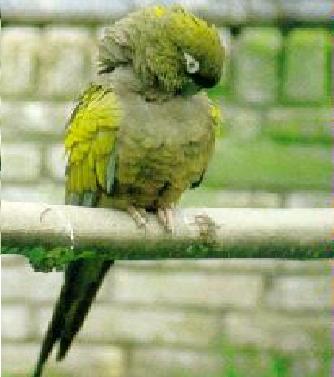Conure - Patagonian, Andean
Scientific Name: Cyanoliseus patagonus andinus
Wed, 2nd July, 2025 - 7:22 pm GMT
Sponsor Ads:

Alternative Name
Scientific Name: Cyanoliseus patagonus andinusBasic Info
The Andean Patagonian Conure's plumage is basically olive green and somewhat darker then the Lesser Patagonian Conure. There is some yellowish tinge on the side of the wings as well as the head. The breast is grey with some blue highlights, though on the Andean Patagonian Conure there are seldom the white markings on the breast as there are with the other two Patagonian Conure subspecies. There is some red on the abdomen and inner thigh. The primary flight feathers are dark blue. The tail feathers are olive green on the upper side and edged in blue. The undersides are dark grey. The Andean Patagonian Conure has white eyes when mature, while immatures have brown irises. The eye is ringed with a bare white area. The Andean Patagonian Conure is the only member of the Conure species that has feathers covering their nostrils. The beak is black on the adult and the upper beak is white on the young. The feet of the Andean Patagonian Conure are flesh colored. They reach an average length of 18 inches at maturity, and the adults achieve their true coloring at one year of age.
Health
When feeding the Andean Patagonian Conure, it is always best to offer either a pellet diet or at least a fortified seed diet. As with most parrots, always offer them fresh fruits and vegetables, as well as foods such as beans and cooked eggs. Fresh water daily is necessary, as is removing fresh food quickly so it does not spoil. The Andean Patagonian Conure only needs a vitamin supplement if on a strictly seed diet. The size of the cage should be sufficient to accommodate their wings and room to play. Usually, a 24" by 24" by 36" cage will do, but bigger works well, too. A variety of perches is good exercise for the Andean Patagonian 's feet, and make sure the food dishes are not directly below a perch, so the food and water is not soiled. Toys are necessary, since Conures are good chewers. Like all Conures they love to bath and they should be misted regularly, and a bath should be provided in their cages. Conures may be prone to a vitamin K deficiency and a bleeding disorder, but with the proper nutrition, those can be avoided. Conures are also good flyers, and require more clipping, but never too much, so the bird will fly gently to the floor. Breeding The breeding season for the Andean Patagonian Conure begins in December but sometimes as late as March. Their nest box should be vertical and 14x14x24 inches. They usually have three eggs in a clutch, with incubation lasting 24-25 days. The babies will fledge in about eight weeks. The males do take part in their care and have been seen feeding the chicks in the nest.Habitat
They can be found in bushes, trees, as well as on cliff-sides during breeding season.Behavior
The Andean Patagonian Conure is one of three subspecies of Patagonian Conure. The Patagonian Conures are by far largest of all the Conures. Andean Patagonian Conures are very active. They love to play, climb and chew on toys, making for an entertaining parrot. Their ability to talk is quite good, though they can be very noisy. The Andean Patagonian Conure is known for its sweet personality. These are intelligent parrots and many learn to talk and bond well with people, especially if hand-raised. In the wild, these birds like to make their nests in the sides of cliffs, earning them the nickname "Cliff Dwelling Parrots". The Andean Patagonian Conure has been known to live as long as 25 years, but their average lifespan is 12 years.Origin
ArgentinaHistory
The Andean Patagonian Conures are native to Argentina. Though their flock numbers were large at one time, they are mostly spotted in smaller groups and usually when eating. The Andean Patagonian Conure, though once common, is now rare in the wild. This decline has been caused by many factors, including hunting and development of their habit. Currently laws have been developed to help protect the current population.Common Foods
N/ASponsor Ads:
What do you call 500 bureaucrats at the bottom of the Potomac river? A start. -- Unknown
Conure - Patagonian, Andean
Coded by: BGID® | ALL RIGHTS RESERVED Copyright © 2000-2025
Disclaimer | Privacy | Report Errors / Contact | Credits

 Why haven't we as a collective earth met with aliens yet?
Why haven't we as a collective earth met with aliens yet?  World EcoSystem - Biodiversity Changes - Who is on board and who isn
World EcoSystem - Biodiversity Changes - Who is on board and who isn  Homosexual behavior stems from the mind or genetics?
Homosexual behavior stems from the mind or genetics?  The Best Text Adventure You Will Ever Play! The official site:
The Best Text Adventure You Will Ever Play! The official site:  Mouthwash - Mouthrinse - Mouth Sores - Healing Infections - Gingivitis
Mouthwash - Mouthrinse - Mouth Sores - Healing Infections - Gingivitis  Treatment for Depression
Treatment for Depression  Ultra radical and violent Islamist group that even rivals Al Qaeda
Ultra radical and violent Islamist group that even rivals Al Qaeda  An idea to have teachers who want to carry guns to school undergo some level of police training will be left up to local school districts and police departments.
An idea to have teachers who want to carry guns to school undergo some level of police training will be left up to local school districts and police departments.